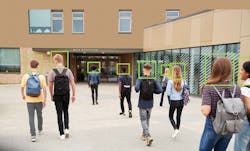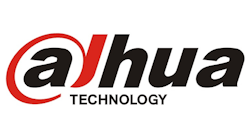As artificial Intelligence (AI) becomes an increasingly common feature in security products, it is finding its way into one of the most quickly-growing security markets – school campuses.
In their annual survey of public schools, the National Center for Education Statistics (NCES) recently reported that 81 percent of public schools have video surveillance cameras installed, up from just 19 percent in the year 2000. This increase in security measures brings new challenges, among which are addressing privacy concerns, reducing the workforce needed to observe surveillance feeds and maximizing the benefits of video surveillance.
The safety of students, faculty, and staff is of course the top priority. The good news is that advanced security systems using AI-based technologies are working to ensure it.
The Basics of AI
First, it is crucial to understand what AI is and how it works. AI is a technology that enables a machine, such as a video surveillance system, to perform tasks that traditionally require human intelligence to execute.
AI is powered by deep learning and machine learning technologies – two additional buzzworthy and often-confusing terms. Machine learning algorithms improve themselves in response to the data to which they are exposed. This complex technology benefits a school campus by making security devices perform more effectively, a major advantage for school districts with limited budgets.
Of those 81 percent of public schools using video surveillance, only 57 percent have security staff on site, according to NCES. This indicates that many of these security systems are not actively monitored, greatly impeding their ability to mitigate security and safety incidents; however, a computer never gets bored or distracted. With AI at the helm, exceptional persons, objects or activity are brought to the security operators’ attention – thus empowering the human staff to be active participants without the burden of constantly viewing tedious, unexceptional activity.
There are two kinds of databases used with AI: static and dynamic. Static means that a user must manually import information into the system, such as uploading photos from student IDs. The camera would then be able to match student ID photos to the surveillance images it is capturing of the students. A dynamic database enable the camera to take snapshots of each face it views and input them into a database it creates automatically. In both cases, the camera can then keep track of each time the same face appears in the scene.
It is important to remember that a system using machine learning or deep learning is expanding its capabilities over time. Case in point: When voice-activated assistants were first introduced to the market, they could only answer questions they had been programmed to answer; however, once they had been in use for a few years, they incorporated not only the answers from their original programming, but the answers to all the questions they had been asked for which they previously had no answer. In other words, their data set increased, and with this, a better chance they would know the answer to your question. Translating this into a video surveillance scenario means that machine learning and deep learning are continually improving the accuracy of things like facial recognition.
AI-Powered Facial Recognition
Facial recognition has numerous potential applications in a school environment, such as identifying a stranger who has never been inside the school before, or a stranger who has been lingering around the campus.
The security system can be configured to send alerts when a person has entered a restricted area: if someone gets banned from the library, for example, the camera will notice if they decide to visit the library anyway.
On the flip side, facial recognition can discern the people who are permitted in the space – for example, specialized turnstiles integrated with cameras can identify the students who are scheduled to be in the library during a certain class period and grant them access accordingly. This type of system is more efficient than having an employee ask for student IDs and manually check them in; and it is more secure than RFID, where students can lose their keycards or loan them to other students.
Other AI-Powered Functions in Schools
While facial recognition is the feature that many usually associate with AI, the technology is being implemented within other intelligent video analytics. Perimeter detection is benefitting from AI, as the technology behind tripwire and line crossing functionality is becoming more precise. Machine learning comes into play here, helping reduce false alarms in scenarios where a tree branch sways in the wind or a husky raccoon scales the fence to get into the dumpster behind the cafeteria. Once a camera learns how to differentiate these harmless distractions from actual intruders, it will only send alerts when security is really at risk.
People counting functions enable a camera to carefully track the number of people coming in and out of a particular entrance – or even all entrances – and quickly provide an up-to-the-minute tally in an emergency situation. If there is a situation where the school needs to be evacuated, school administrators can rely on the data from the video surveillance system to tell them how many students entered the school that morning and how many exited the building during the evacuation. Advanced analytics can further support people-counting efforts by keeping track of how many people are supposed to be in a given location and sending an alert when, for example, the school auditorium is approaching maximum capacity and fire codes might be violated.
License plate recognition (LPR) is being used by schools to keep track of authorized vehicles on campus – whether it be making sure that only faculty vehicles are in faculty lots, or identifying which cars are pulling into the lane designated for after-school pickup. When an unauthorized plate is detected, an alert can be sent. This sounds like a great way to make the most of human resources – because a human no longer needs to manually check and reference plates – but it is obviously only valuable if the LPR is accurate. LPR cameras have a built-in algorithm called Optical Character Recognition (OCR), which helps the camera recognize the plate. In order for OCR to interpret the license plate with high accuracy, the algorithm needs a large data set from which it can learn over time.
Other fascinating uses of AI are being rolled out in video surveillance equipment, including a cameras’ ability to discern between humans and vehicles within their field of view, and cameras that can classify human behavior and send alerts when aggression or anger is escalating. These capabilities, like much of the ones described above, are invaluable in preventing dangerous or unsafe events from occurring.
Deployment
Along with all of these exciting new technological abilities comes a concern that is being raised by many school districts: how can we implement these security measures without making our students and teachers feel like they’re being constantly monitored? As illustrated in the examples above, AI-enhanced technology is designed to make transfer of data more efficient and more relevant. It is intended to operate automatically and, in most cases, in the background, giving security operators more time and freedom to “ignore” the people who are supposed to be at the school and concentrate on strangers and possible threats.
It is also important to note that AI can be used in such a way that it does not collect any more personal data than what has already been collected – rather, it makes more effective use of that data.
A school will already have students’ and teachers’ photos in the form of IDs, and those images are probably being stored in a database, as well as phone numbers, addresses, dates of birth, Social Security numbers, academic records, class schedules, disciplinary records, teaching credentials, and more. If a school is using RFID readers to scan key cards, there are also records of who has which key card and which key cards can access certain parts of the campus.
School districts also have a serious responsibility to lay out guidelines on how they are going to use student and teacher data and make these guidelines transparent. They must take steps to make sure the data is secure and communicate openly about what the data will be used for, how it will be stored, and for how long it will be stored. Fears of excessive surveillance can be assuaged with a clear plan for managing data responsibly.
AI and machine learning are becoming more advanced and continuing to gain traction in security applications. As such, users and integrators must educate themselves on appropriate uses, the benefits these technologies offer, and how successful integration with existing devices and practices makes surveillance more effective. School campuses, where forward-thinking is part of the curriculum, are perhaps an ideal environment for technological education.
Steve Wilber is Training Manager for Dahua Technology USA. He has more than 20 years experience in video surveillance training, sales, marketing and product management. Request more info about the company at www.securityinfowatch.com/12101368.


